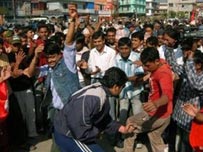
|
|
|
|
|
|
|
|
|
|
|
|
|
|
||
|
|
||||
|
|
|
Nepalese people still on the streets defying curfew and atrocious police actions
Published on May 03, 2009
Curfew in Nepal continued and so also the fighting on the streets between the agitated mass and the police whole day. Today (24th April 2006) is the fifth day, since the 19-day old people�s movement against the royal rule began, that royal authority imposed curfew on the streets of Nepal with a view to keep anti king demonstrators away from the streets and confined the agitators inside home. But royal move and its police force utterly failed to keep the democracy loving people off the street. Even today thousands of people took to the streets defying curfew and police atrocities in the form of tear-gassing, rubber bullet firing, and lathi charge. Although not less than the police killed 19 people so far, nothing deter the mass to press demand for people�s rule in place of rule by royal forman i.e. the direct autocratic rule of King Jnanendra. The men on the streets vowed today a biggest demonstration to take place tomorrow. Here lies the crux of the problem, especially for the royal authority.
As the situation in Katmandu worsened, the fighting between the Maoist rebels spread into rural areas. As for example hundreds of Maoists attacked the army position at Chautar, about 125 km from Katmandu that followed a fighting between them and the army for six hours in which several people died. After rejecting the royal plan of transfer of power, which the 7-party alliance termed as King�s clever manipulation of forming a government in which the monarch will keep key powers in controlling the government, the opposition called for big assembly and rally on the streets of Nepal on Tuesday, April 25, 2006. The big rally of not less millions of people would be presided over by Nepalese Congress leader Girija Prasad Kairala and addressed by top leaders of the alliance.
This has not only shaken the King but also the foreign embassies. The US State department today asked the non-essential staff and their families to leave the country. It also asked US nationals living in Nepal to leave. On Thursday, 20th April 2006, the US ambassador categorically said that King�s rule was numbered, he must admit to the demands of the people for democratic rule in Nepal without King�s intervention.
It is learnt that Indian foreign minister is to see the king and 7-party alliance leaders, obviously with view to find a solution acceptable to the people as well as the king. A difficult proposition indeed. It is also transparent that king is heavily depending on the support of the army and the state police now imposing the curfew and dealing with the mass on the streets.
The police action everywhere is same and identical, whether it is in Nepal or Bangladesh that is immaterial. Compare a picture of the police action on Kansat people, or police charging on hartal people on the streets of Dhaka with that of an action of the Nepalese police, there is hardly any significant difference. King Jnanendra might give up his ego to the people�s desire, but will Begum Khaleda yield to the opposition demand(s). Her advisors would advise not do so, here probably would lay difference of attitude between the King Jnanendra and PM Begum Khaleda.
Prof. Ajoy K. Roy, is a reputed scientist and human rights activist from Bangladesh
|
|
|
|
|
|
|
||
|
|
||||
|
|
|
|
|

